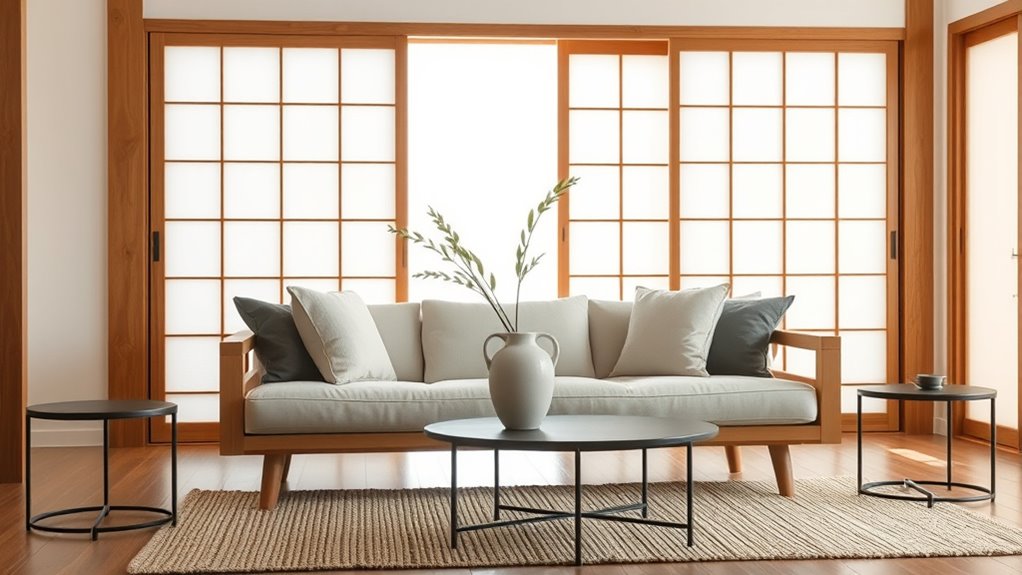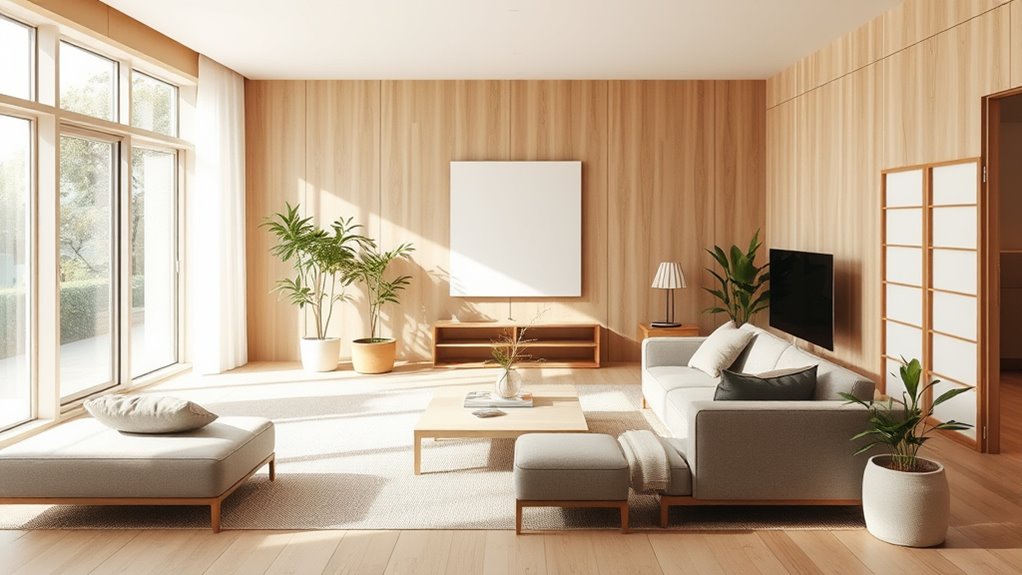Japandi fusion combines Japanese minimalism with Scandinavian coziness, creating spaces that are both peaceful and inviting. You focus on clean lines, open spaces, and a neutral color palette to promote tranquility. Using natural materials like wood, stone, and textiles adds warmth and texture while maintaining simplicity. This balance of pared-down elegance and cozy elements results in a harmonious environment that feels calm yet welcoming. Keep exploring, and you’ll discover how these principles come together seamlessly.
Key Takeaways
- Japandi fusion merges Japanese minimalism’s simplicity with Scandinavian coziness for a balanced, serene environment.
- It emphasizes clean lines, open spaces, and a neutral color palette to create calm, uncluttered interiors.
- Natural materials like wood, stone, and textiles are used to add warmth and authenticity.
- The design combines minimalism with tactile textures to soften the overall look and enhance coziness.
- Prioritizing functionality and intentionality, Japandi fuses aesthetic elegance with practical, nature-inspired accents.

Have you ever wondered how two distinct design philosophies can blend seamlessly to create a harmonious space? When it comes to Japandi fusion, it’s all about merging Japanese minimalism with Scandinavian coziness to craft environments that feel both serene and inviting. Central to this blend is the emphasis on minimalism—stripping away clutter to highlight the beauty of simplicity. You’ll notice how the aesthetic leans toward clean lines, open spaces, and a restrained color palette that promotes calmness. This minimalist approach isn’t about stark emptiness; it’s about intentionality—every piece has a purpose, every space breathes tranquility. Incorporating vetted portable camping gear such as natural materials and functional furniture can further enhance the harmony of your space. Natural materials play a vital role in achieving the authentic Japandi look. You might find yourself drawn to the warmth of wood, the subtle texture of stone, or the softness of woven textiles. These materials not only add visual interest but also foster a connection to nature, which both Japanese and Scandinavian styles cherish deeply. When you incorporate natural materials, your space feels grounded and authentic, creating a soothing environment that’s both functional and aesthetically pleasing. Think of a simple wooden dining table paired with wool throws or a stone vase on a minimalist shelf—these elements bring warmth and character without overwhelming the senses. The beauty of Japandi fusion lies in its balance. By combining the pared-down elegance of Japanese design with the cozy, functional elements of Scandinavian style, you create a space that’s neither cold nor cluttered. Instead, it’s a harmonious blend where minimalism is softened with natural textures, and clean lines are complemented by tactile warmth. This balance allows you to relax and focus, whether you’re working, entertaining, or unwinding. The key is to curate carefully—select pieces that reflect both styles’ core values—simplicity, functionality, and natural beauty—so your space feels cohesive and inviting. As you design or redesign your home with Japandi principles, remember that less is more. Use natural materials thoughtfully, emphasizing their textures and grains to add depth. Keep your color scheme subdued, favoring neutral tones like taupe, beige, and muted greys, with occasional accents inspired by nature. This approach helps create a space that’s not only visually appealing but also emotionally restorative. Ultimately, Japandi fusion celebrates the idea that simplicity and natural materials can come together to craft a space that nurtures the soul, offering tranquility amid everyday life’s chaos.
Frequently Asked Questions
How Do I Balance Minimalist and Cozy Elements in Japandi?
To balance minimalist and cozy elements in Japandi, focus on creating textural contrasts that add warmth without clutter. Use soft textiles like throws and cushions alongside sleek furniture to enhance functional aesthetics. Incorporate natural materials such as wood and stone to evoke coziness while maintaining simplicity. Keep the space uncluttered and prioritize quality over quantity, blending clean lines with inviting textures to achieve a harmonious, balanced look.
What Are the Key Sustainable Materials Used in Japandi Design?
Think of sustainable materials in Japandi as nature’s gift to your home. You’ll want to incorporate reclaimed wood, which tells a story of history and renewal, and organic textiles that feel soft and pure. These eco-friendly choices help you create a serene, responsible space. By using reclaimed wood and organic textiles, you embrace sustainability, blending beauty and conscience seamlessly into your Japandi-inspired design.
How Can I Incorporate Japandi Principles Into Small Spaces?
To incorporate Japandi principles into small spaces, focus on compact storage solutions that maximize your area without clutter. Use multi-functional furniture, like a sofa bed or a storage ottoman, to maximize utility while maintaining a minimalist aesthetic. Keep the color palette neutral and natural, and incorporate simple, clean lines. This approach creates a serene, functional environment that reflects Japandi’s harmony between form and purpose.
What Color Palettes Are Most Effective for Japandi Interiors?
You should choose neutral tones like soft beiges, warm greys, and muted whites to create a calming backdrop. Then, add bold accents—such as deep navy, black, or rich terracotta—to bring contrast and interest. Imagine a serene, minimalist space with a striking black vase or a vibrant throw pillow. This juxtaposition of subtle and bold hues captures the essence of effective Japandi interiors, balancing tranquility and visual impact.
How Does Lighting Influence Japandi Ambiance and Mood?
Lighting plays a vital role in creating the calm, harmonious atmosphere in your Japandi space. You should use ambient lighting to softly diffuse light, avoiding harsh shadows, and maximize natural illumination during the day to enhance simplicity and warmth. Combining these elements helps you achieve a tranquil mood, emphasizing clean lines and cozy textures that define the Japandi aesthetic. Proper lighting makes your space feel inviting, balanced, and serene.
Conclusion
By blending Japanese minimalism with Scandinavian coziness, Japandi fusion creates a space that’s like a peaceful lake at dawn—calm, balanced, and inviting. You’ll find that this design style offers the perfect harmony of simplicity and warmth, making your home feel both serene and welcoming. Embrace Japandi fusion, and watch your space transform into a sanctuary where every element works together like a well-choreographed dance, offering tranquility and style in perfect unison.








